Art Inspiration from Sanditon
This blog post is for us who love Jane Austen and Sanditon tv series. I watched the series last month, and it has inspired me a lot. I hope you enjoy this Sanditon inspiration overload!
Torchbearer – Esther and Lord Babington on the Beach
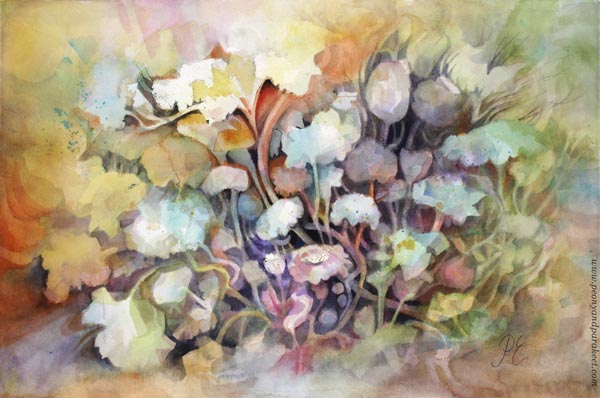
My newest watercolor painting called Torchbearer had a modest beginning and I had no clue how to finish it – until I saw episode 8 of Sanditon!
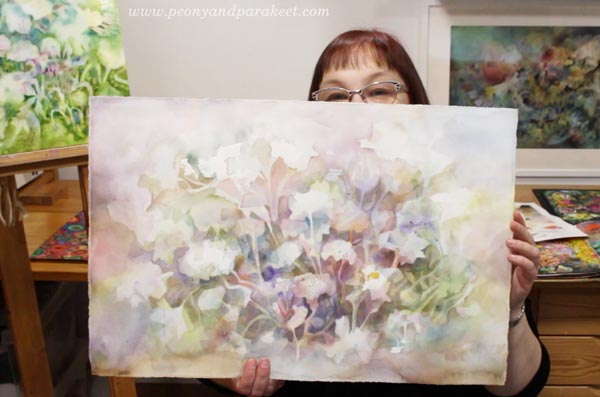
My favorite female character of Sanditon is Esther and the scene where she is in the carriage with Lord Babington was so romantic! The sudden change in her appearance, his gentle smile, black horses, empty shore – oh my! It hit me, that even if my painting has flowers, not people, I could express the emotion from the scene.
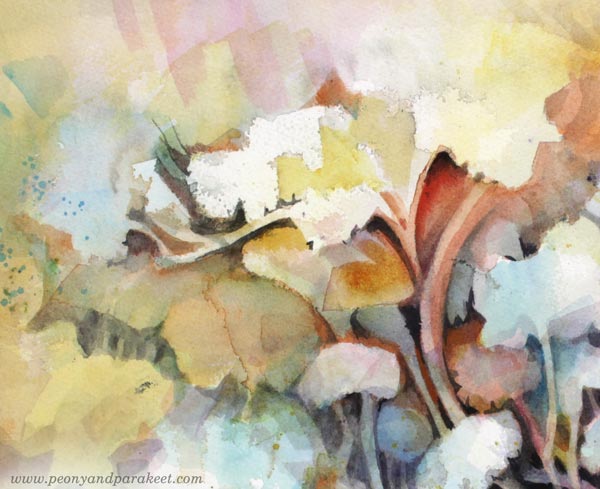
The tallest flower and the glow come from Esther’s powerful spirit.
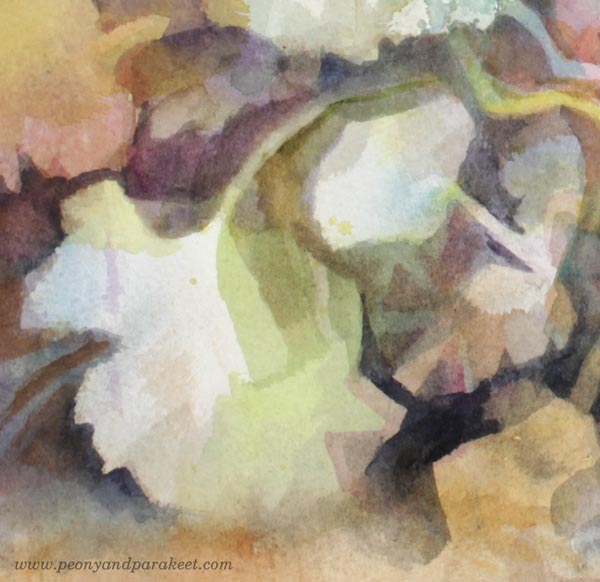
The flower that bends down, expresses her sensitivity.
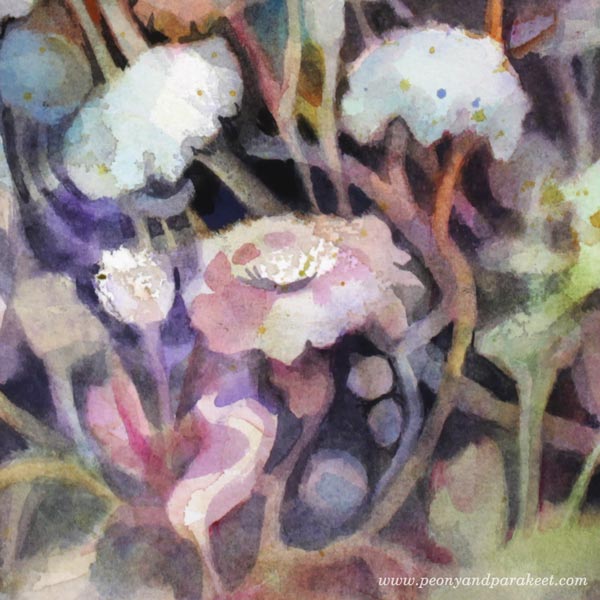
I tried to paint every flower so that they highlight the bubbling energy. Their stems are like the carriage where the couple sat.
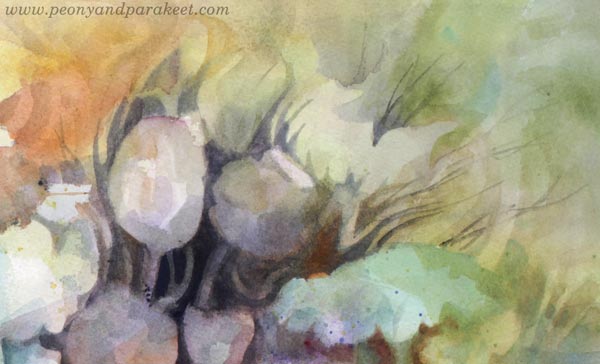
The black background represents both the horses and the lord, supporting Esther’s joy.

In this painting, Esther is a torchbearer who leads us to better times.
Tin Box – A Souvenir from Sanditon
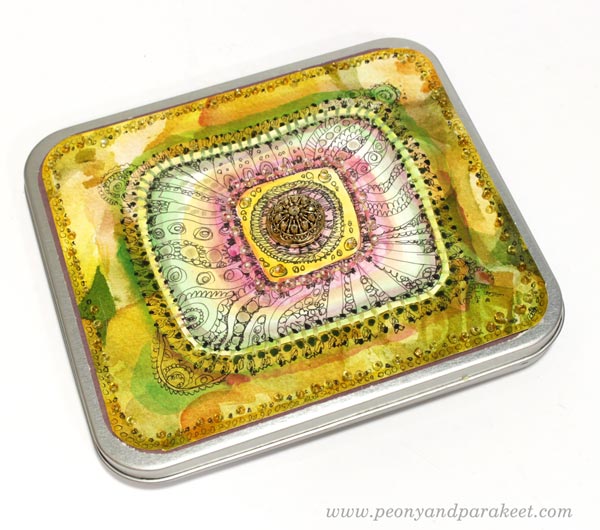
I like little boxes that can be used for storing hand-drawn pictures and papers. I wanted to decorate a small tin box so that it would have old-fashioned and luxurious feel. So that I could think of it as a souvenir from Sanditon!
I already had saved a hand-drawn piece that was quite perfect in size.
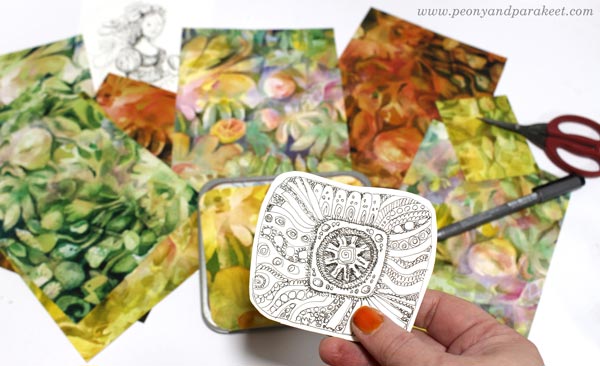
I also found some papers with a watercolor print. They were test runs of the surface pattern designed earlier this year. I mostly designed the pattern manually, so by painting a design on the center of the paper and then cutting the paper into four parts.
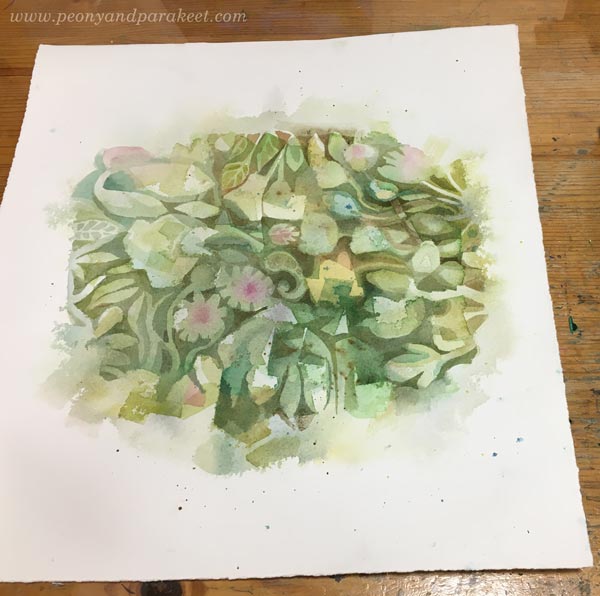
This way you get a continuous design.

Avoid painting edges, and re-arrange papers until they are all fully painted.
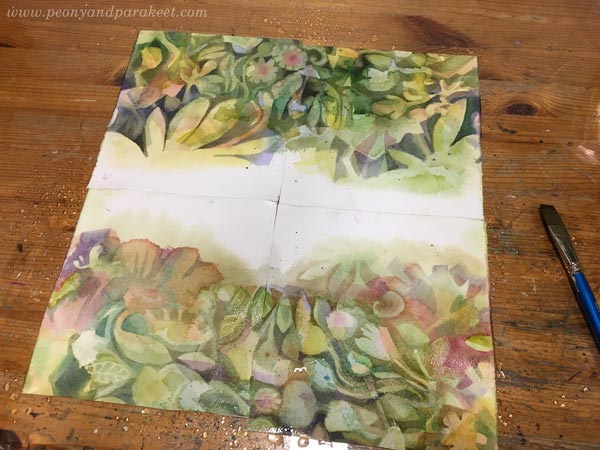
Then scan the papers, and clean the edges in an image processing software. Here’s a sample of my design.
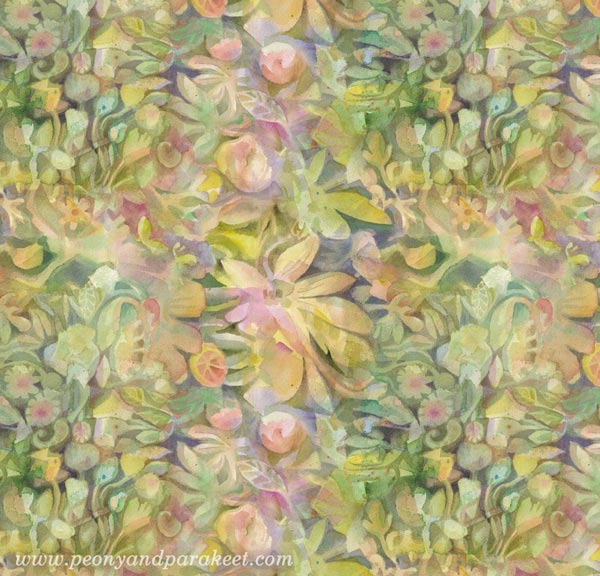
I made several variations in Photoshop. These papers go really well with hand-drawings, so they were perfect for the box.

The center motif was first colored with watercolors.
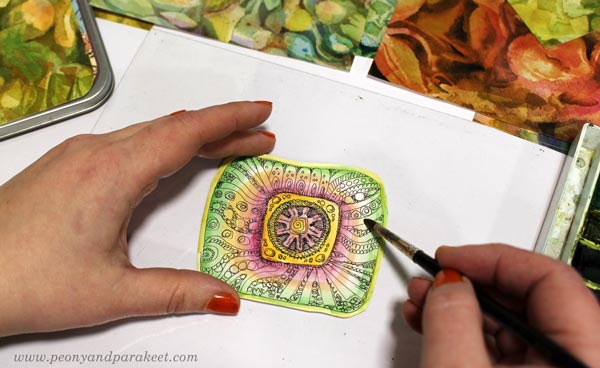
Then I hand-stitched it on a background paper and added more hand-stitching around the center. In the photo below, I highlight the surroundings of the stitches with a pen so that they look more 3-dimensional.
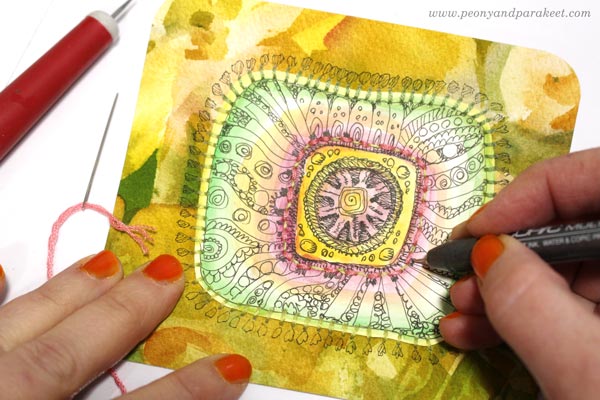
I also added beads, more colors and decorative marks.
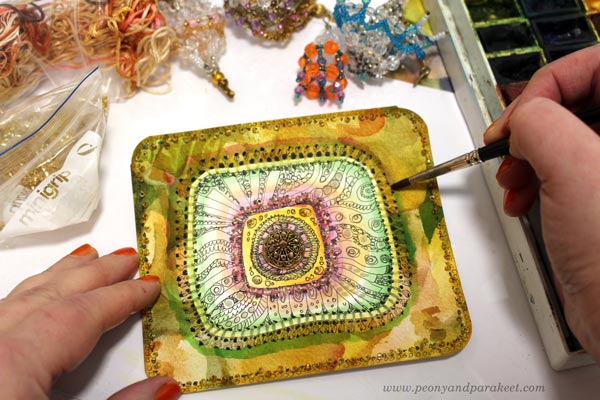
The centerpiece is a button with a shank removed. I love this little box!

Esther Denham – Sanditon Paper Doll
I also wanted to create something for my ever-growing collection of collage figures. “Just an unknown habitat of Sanditon”, I decided first. I didn’t use any reference and drew the doll just freely, but when she was colored, she looked just like Esther!
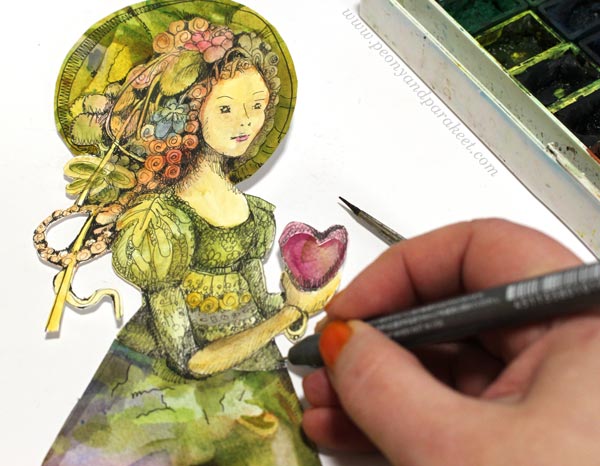
I played with her proportions so that she has overly long legs. That way I could make the dress more imaginative. The hem was cut from one of the watercolor papers. I couldn’t help playing with her right away, trying wings on her, filling the teacup with herbs from Sanditon. The wings and the teacup are from my fun class Magical Inkdom.
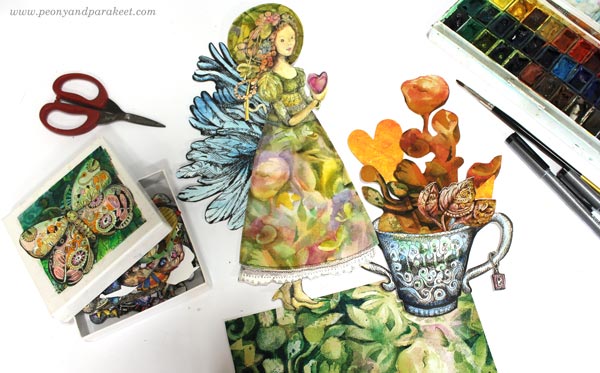
Her hat is also a collage piece cut from watercolor papers.
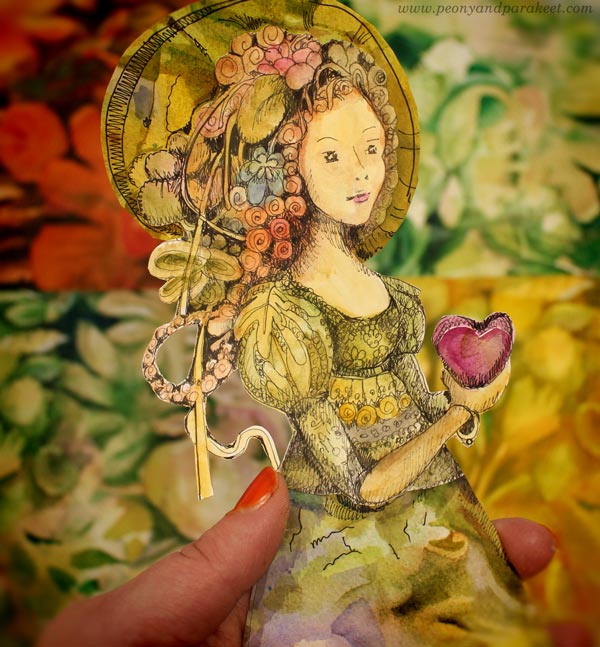
Souvenirs from Sanditon!
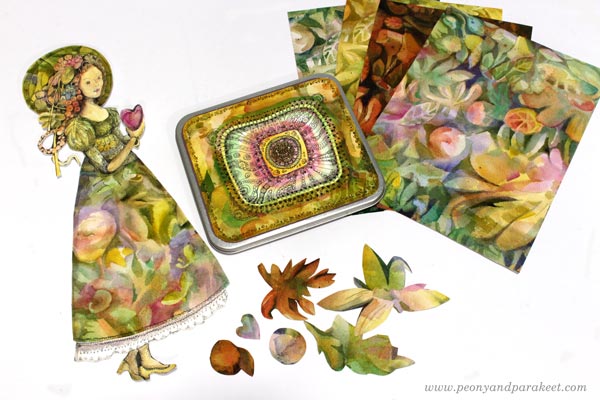
The Romance Continues
I am currently painting an oil painting that looks quite romantic already.
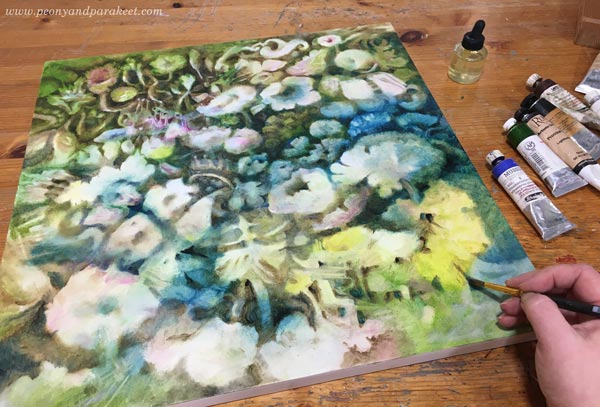
My vision is to make it the third in the series after Icebreaker and Torchbearer – and put it in the middle of them.
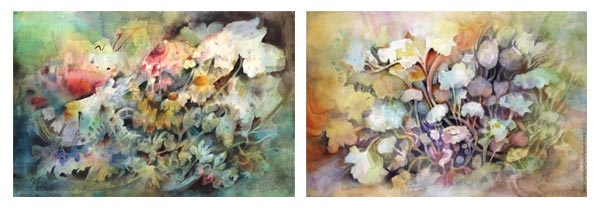
One Source of Inspiration – Many Interpretations
If you have been following my blog, you know that some of my projects are fine art, others more illustrational, and there can be a bit crafty things too. This blog post demonstrates well how the inspiration can be the same, but the interpretation is different. For me, the wide range of projects is a way to stay inspired and creative, and I hope that you have tolerance for all of them. I don’t believe in getting too serious or not getting serious at all. The humorous side of art allows us to get playful, and the playfulness feeds our ability to express the deeper side of our inspiration.
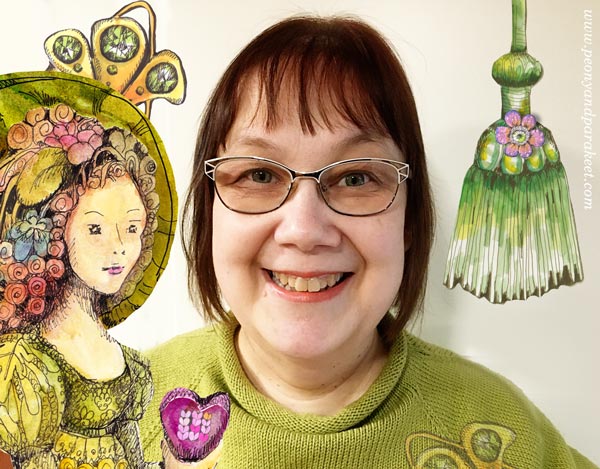
Esther can be the person who handed me a crafty gift box, or an innocent paper doll, or a mysterious flower in a painting that took tens of hours to create. The key to your artistic style is less in the looks and more in the inspiration. For me, it’s often old-fashioned romances, like Sanditon.
Welcome to my online classes!
– Paint watercolor fantasies – Sign up for Magical Forest!
– Draw the magic – Buy Magical Inkdom!
Doodler’s Sampler Step by Step
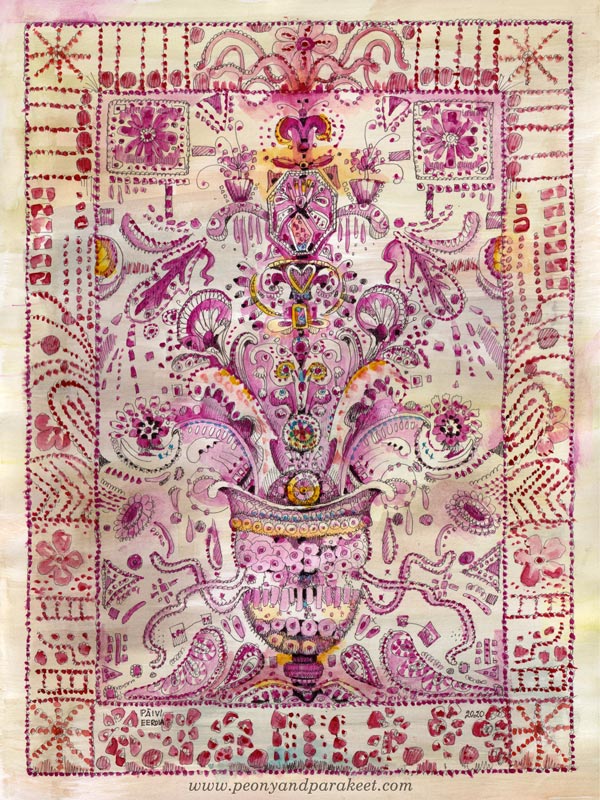
I have always loved antique embroidery, and it inspires my art too. This week, I invite you to treat your pen as a needle and doodle the look of the precious hand-stitched fabric. My drawing – I call this Doodler’s Sampler – is 9 by 12 inches but you can make a smaller or bigger piece with these instructions. The best paper for this is Bristol paper. It’s smooth and nice to color with watercolors.
Step 1 – Draw a Grid
Because we aim for ornamental stiffness, a grid helps to place the elements. Use a pencil so that you can erase the lines before coloring. Start by outlining a space for a frame. Then divide the rest of the paper so that they help to place the main elements.
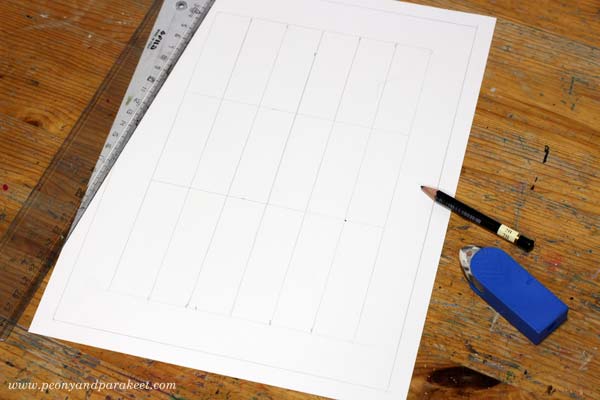
I wanted my Doodler’s Sampler to be symmetrical, so I drew a vertical centerline, and then divided the two halves into three parts. Another idea that I had was to have a vase of flowers. So I drew horizontal lines that mark each third, and the lowest third is reserved for the vase.
Step 2 – Sketch the Structure
Old samplers are filled with decorations but at the beginning, it’s enough to sketch the places for the biggest elements and their shapes.
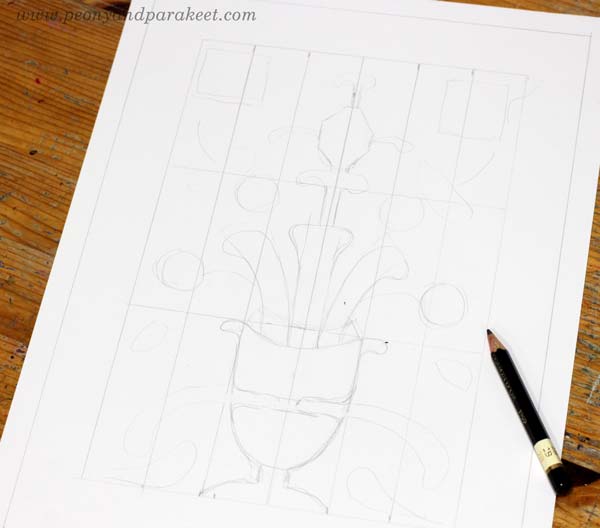
I wanted to have something rectangular on the top corners, the vase on the bottom, plant-like organic shapes coming out of the vase, and then an angular jewel-like thing on the top of the ornament.
Step 3 – Doodle and Decorate
Pick a thin-tipped drawing pen, that has permanent ink, and start doodling! Make more shapes and fill them with circles, rectangles, flowers, hearts, anything you can think of!
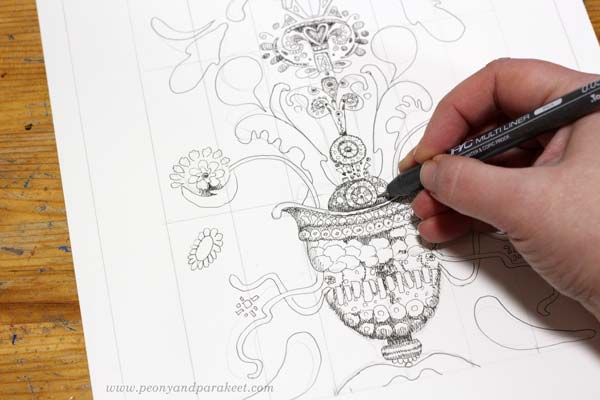
My pen is Copic Multiliner, tip size 0.05. I add shadows to my doodles so that they don’t just outline the shapes but there are darker parts too.
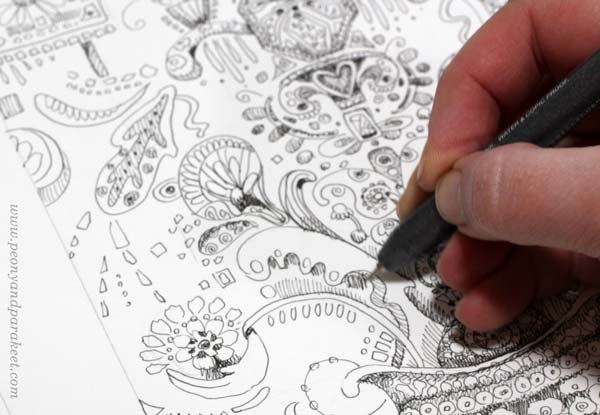
I make the decorative border simpler so that it doesn’t take the power away from the centerpiece. Trembling lines look more decorative than straight ones.
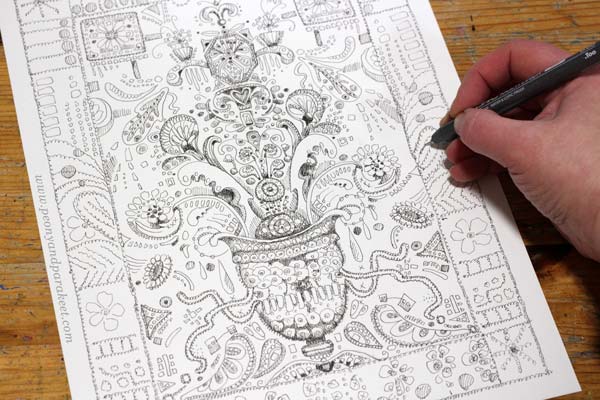
Here’s my Doodler’s Sampler after Step 3, ready for coloring.
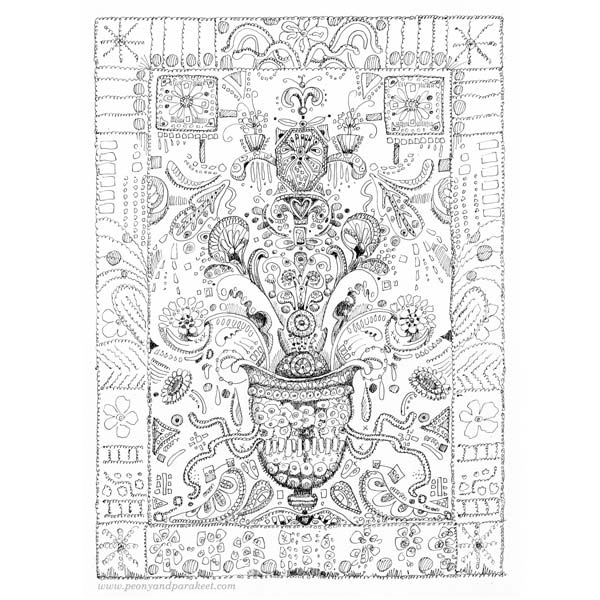
Step 4 – Color the Background
You can use any supplies for coloring, but in my opinion, the softness of watercolors complements the sharp black lines best. Start the coloring by adding some color to the background.
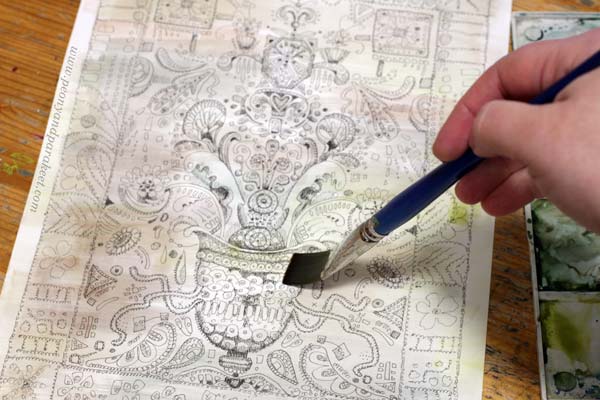
I use very little pigment and many tones so that the background looks like old antique linen.
Step 5 – Color the Doodles
Pick one main color for the sampler. My choice is cool carmine red. When coloring, add more decorations like dots and other decorative shapes. You can also color around a shape instead of inside the shape.
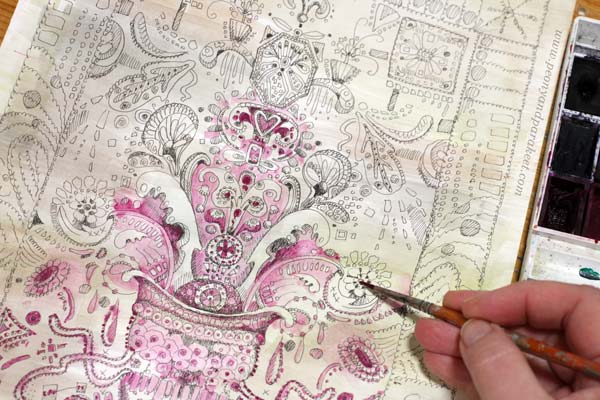
Pick slightly different tones for the frame. I use warmer red and a little bit of orange.
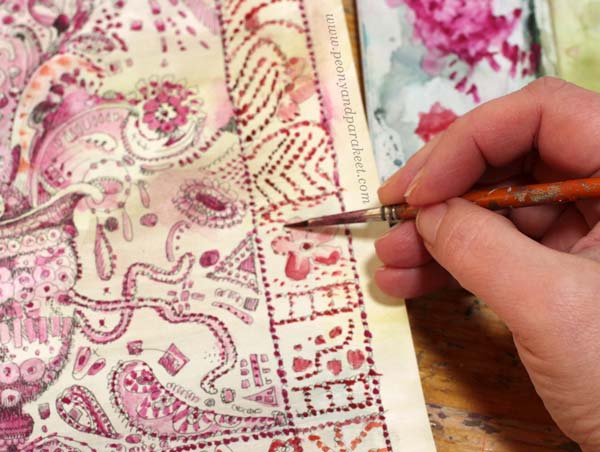
When you have colored the sampler with a very narrow color scheme, make it more lively with some new tones.
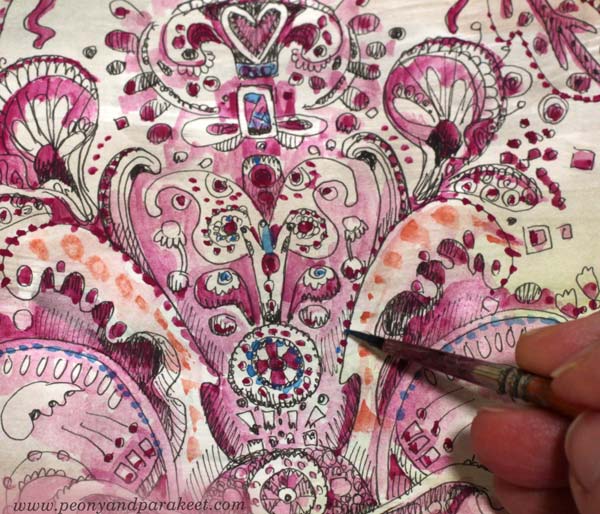
I added blue and yellow, but very sparingly.
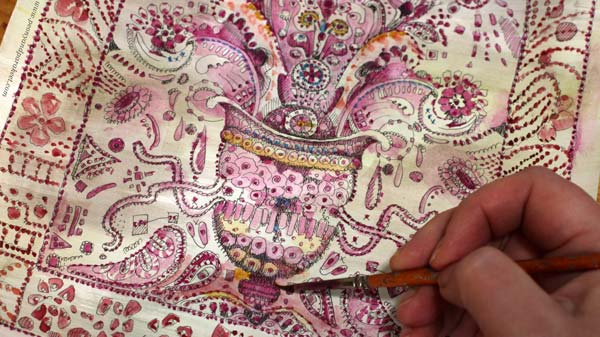
You can also highlight the main elements by making the darkest areas pitch black.
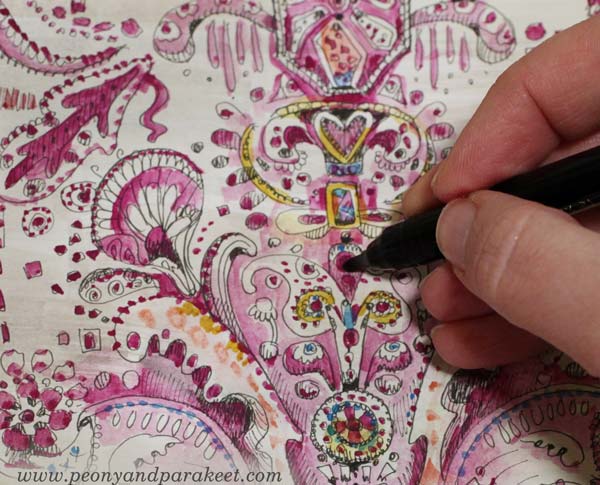
Here are the black and white version and the colored version side by side. Click the image to see it bigger!
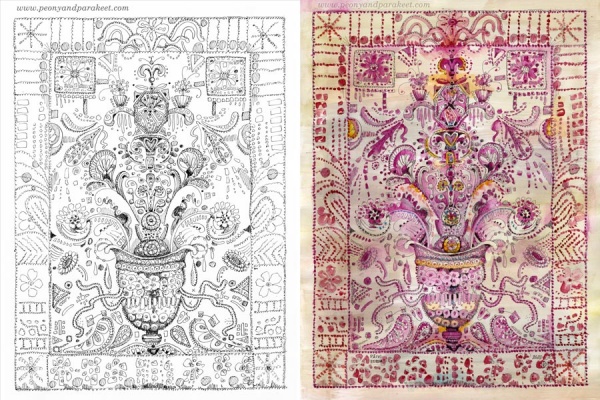
Doodler’s Sampler – For the Love of Flowers and Hand-Stitching
Henri Matisse has said: “I don’t paint things. I only paint the difference between things”. I think that to me, it goes like this: “I don’t paint things. I only paint the similarities between things.” So here’s for the love of flowers and hand-stitching!
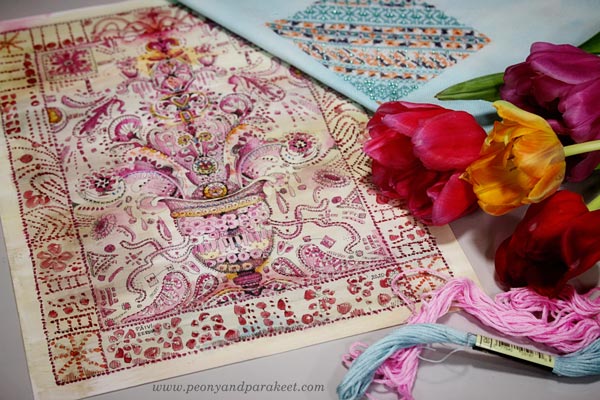
Draw more with me – Check the courses Animal Inkdom and Magical Inkdom!
Hand-Drawn Collage Samplers
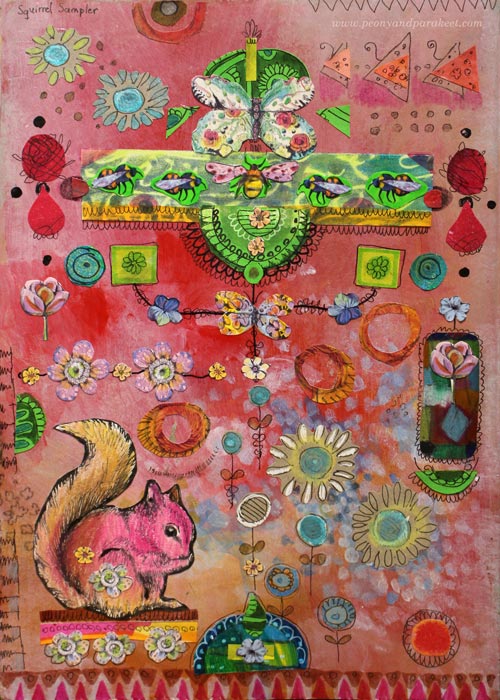
I have been browsing my art archives lately, and it has been surprisingly inspiring. I have lots of art journals and a big box of paintings and drawings from my teenage years. Even if I have experimented with many techniques and themes, it all looks very similar now. Everything fits together and gets my approval. Painting “Icebreaker” gave me a new kind of confidence, and with that confidence, I am now blogging about a playful idea that I got from cross-stitching – hand-drawn collage samplers!
These samplers are composed of hand-drawn paper pieces so that they look like cross-stitch samplers. They have ribbons, many identical ornaments, tiny floating elements, and some symmetry. There’s also stiffness and order so that it looks like the elements are on a grid.
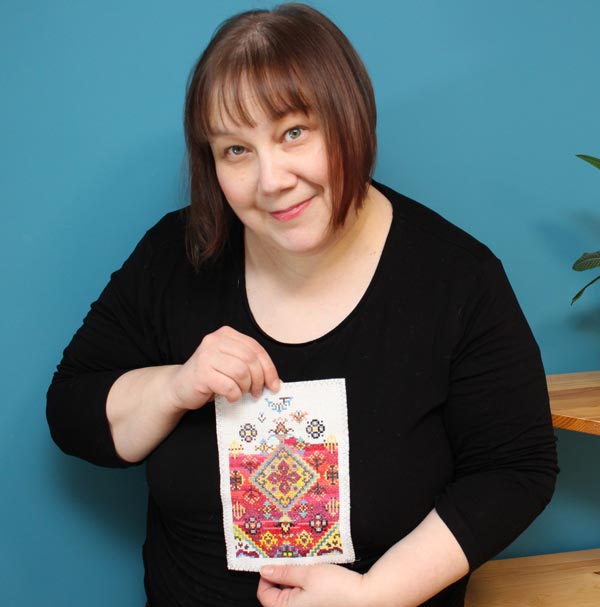
Cross-stitching is one of my hobbies, and even if I try not to think about art when stitching, I just couldn’t resist this idea! Here’s how I applied cross-stitching to collage art.
Print Tiny Scans of Hand-Drawn Collage Pieces!
It’s essential to have tiny decorations to make the collage look ornamental. I solved the problem by making collage sheets of scanned hand-drawn pieces. These collage elements were drawn for the classes Animal Inkdom and Magical Inkdom, and there are some jeweled flowers from the free mini-course for subscribers too.
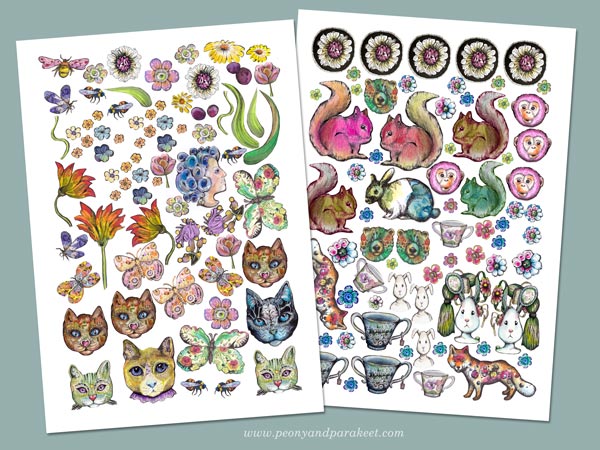
The original size of these pieces is much bigger than in the printed sheets.
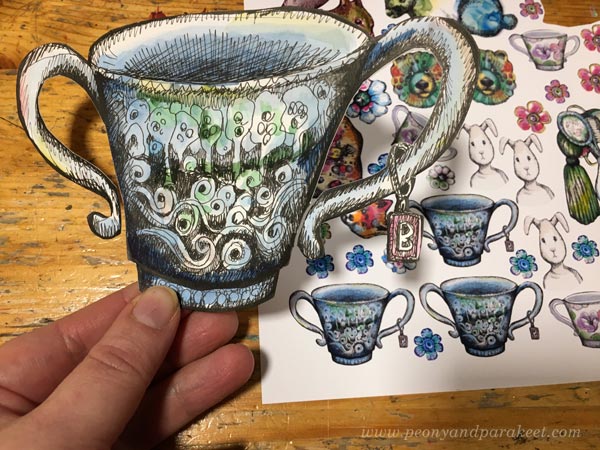
Use All Kinds of Hand-Decorated Papers!
Samplers have a variety of designs, so every little doodle is a potential sampler piece. I have a box of hand-decorated and painted papers (mostly leftovers from Collageland) and two boxes of hand-drawn collage elements. I have also cut some old art created in the 1980s. All these are a good addition to small printed pieces.
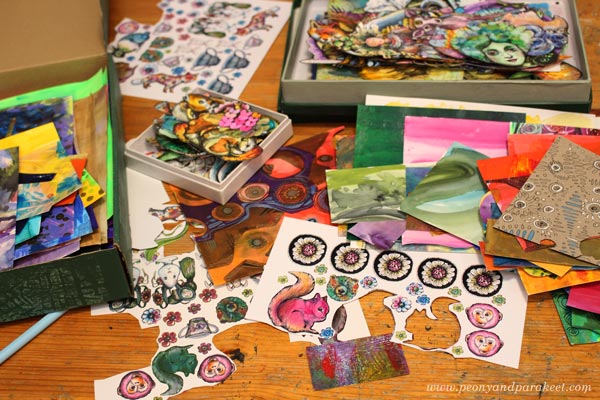
Of course, you can also use store-bought die-cuts, pictures from magazines, etc. but if all the elements are handmade, they will all fit together much better because they are all YOU!
Perfect Project for Hand-Painted Background Pages
If you are an art journaler, I bet your journal has a lot of pages that are more like backgrounds rather than finished pages. You can use them for collage samplers!
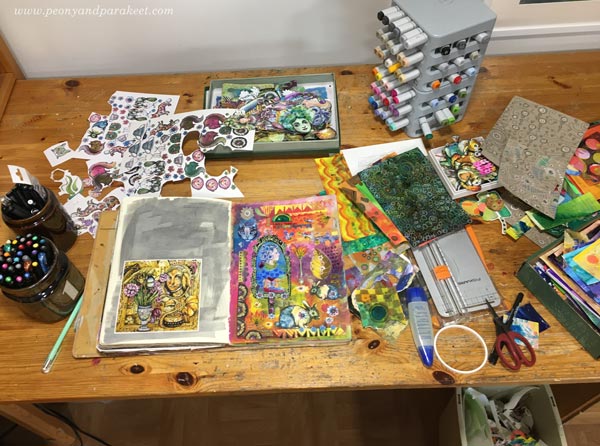
The background of this sampler was busy and bright, but I just added brown over some of the areas and let the colors speak, or should I say shout!
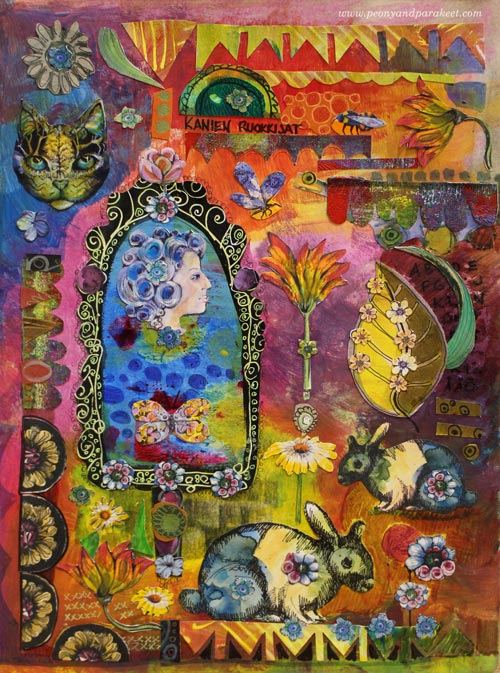
I attached the pieces with paper glue and some larger elements with double-sided tape. I usually use gel medium, but it’s messier, and it’s too difficult to cut all those tiny pieces with sticky fingers.
Self-Expression with Hand-drawn Collage Samplers
Sticking paper pieces can be just a relaxing hobby, like cross-stitching. But samplers can also tell stories!
My first page is called Squirrel Sampler, and it has all kinds of little treasures that Paivi the Squirrel has collected.
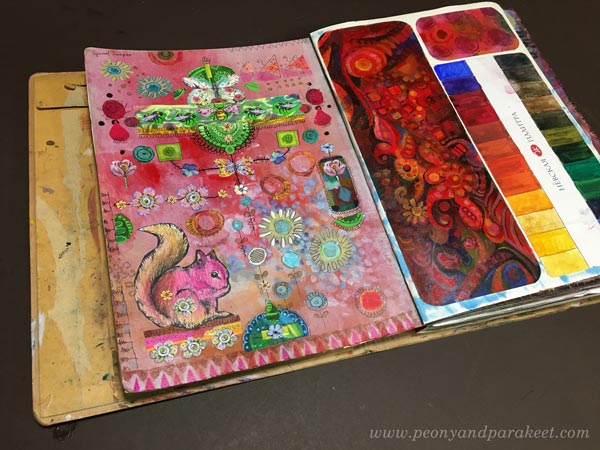
The second page is called Rabbit Feeders. It refers to women’s status and importance in Virginia Woolf’s novel The Voyage Out. An isolated woman looks at herself from the mirror and questions her importance for the world. I read Voyage Out as a teenager, and this allegory, even if it’s just a few rows in the book, touched me deeply.
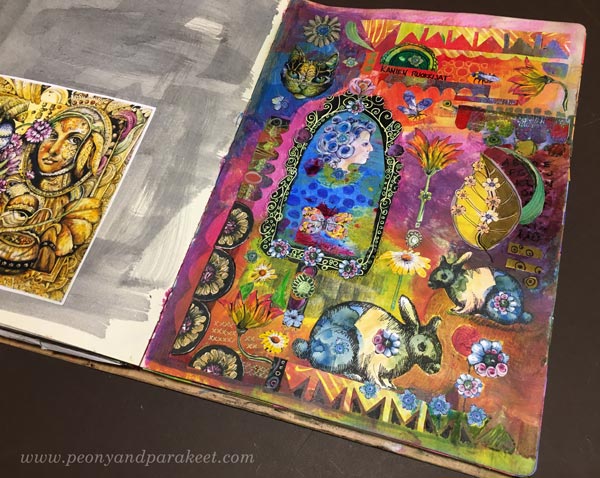
It often happens that creative play evokes feelings and stories that are too big to express in any other way. I hope you’ll enjoy making these samplers!
Start drawing your sampler pieces – Subscribe to my weekly emails and get a free mini-course!
The Beauty of Science – Illustrating a Children’s Book
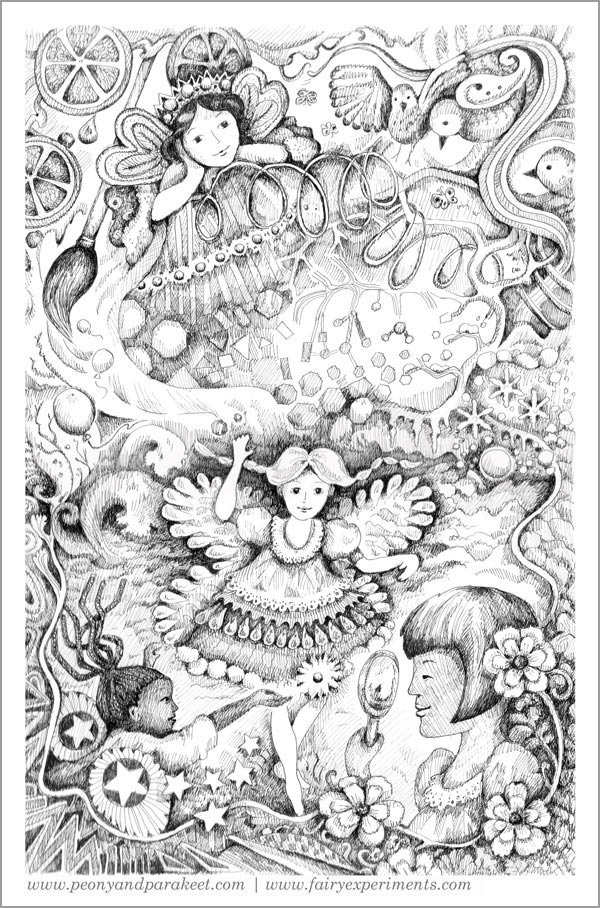
This week, I want to show an example of how we can use art to change the world. My example is about illustrating science so that it also appeals to those who love beauty and fantasy. When we talk about inclusiveness, we often talk about what words to use and how but rarely talk about the style of images. My questions for you this week are:
How could your art invite people to try new things or to think in a new way? How could your art make new people feel included right away?
Fairy Experiments for Thinkers and Tinkerers
Last fall, I was hired to illustrate a children’s book. It was a big project – well over 60 images and ornaments, including the illustration for the cover, shown above. The book is called “Fairy Experiments For Thinkers and Tinkerers” and its goal is to inspire young girls to explore science through fun experiments. The book hasn’t been published yet, but my client C.L. Hunt has an email list where you can sign up to get notified when the book goes on sale: www.fairyexperiments.com
Black-and-White Drawings in Victorian Style
The book combines fantasy and science in a fascinating way. My client wanted to have black-and-white hand-drawings with a Victorian feel.
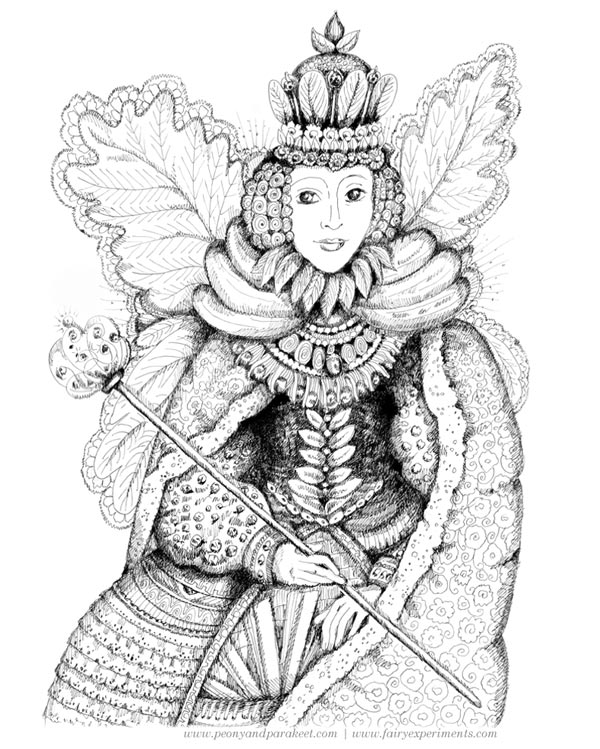
Illustrating the Feminine Beauty of Science
This project soon became close to my heart. As a child, I fell in love with science at school and then later, studied software engineering at The Helsinki University of Technology. Natural science, especially physics and mathematics have always interested me. As a young girl, I bought copper sulfate from a pharmacy because I thought it was so beautiful. I warmed it to make bigger crystals from the powder and loved the glow.
I have had a few women, teachers and mentors, who have supported me during my career in technology. But I have also always known, even as a young girl, that I was in a masculine world. The assignments and the culture often felt strange and yes – let’s say it aloud: not beautiful at all.
Science is not just bolts and levers, it’s also a world of glitter, shimmer, and sunsets. Nature’s transformations, the structure of the universe, and the fascinating microcosmos are full of aesthetics. And still, most science books don’t show that beauty, at least not in a feminine way.
In this book, my goal was to combine intelligence and beauty so that the feel of the images is inviting and light-hearted too.
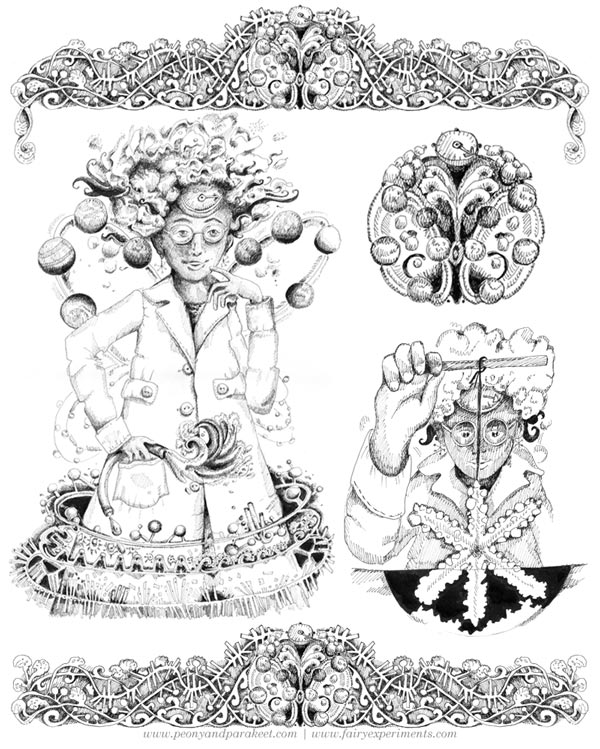
I was excited when my client wanted to combine fairy fantasies and practical science experiments. We were on the same page from the very beginning. In the end, she summarized the project:
“Paivi understood and appreciated my project, and her enthusiasm has kept me motivated to keep working on it. The images are very well suited to my book, and their style is exactly what I was looking for. Paivi kept to her schedule, communicated well when I had questions, and I was really happy creating a shared vision with Paivi. I recommend her warmly.”
– C.L. Hunt, the author of Fairy Experiments For Thinkers & Tinkerers”
Illustrating Girl Power – Stepping away from a Passive Role
Even if we wanted to show the beauty of science, the fairies needed to be more than pretty faces and poses. In the illustrations, fairies take an active role and make the most of nature’s forces. I drew plain and classic dresses for the fairies so that action gets the attention.
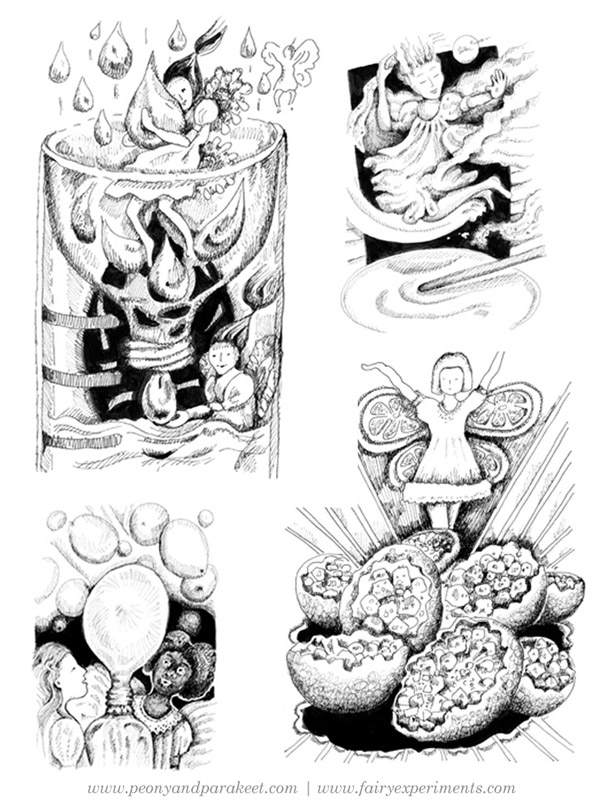
My client also wanted to have a variety of ethnic groups so that every girl can feel that the book is for her.
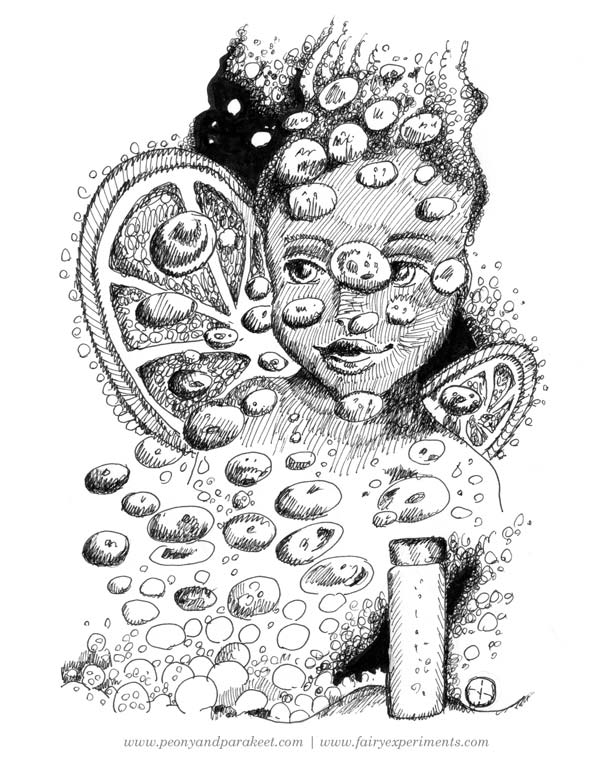
Illustrating Science with a Flair of Fantasy
In the manuscript, there were wonderful descriptions that built bridges between reality and fantasy. My job was not only to demonstrate the essentials of the experiment but also tie them with imagination.
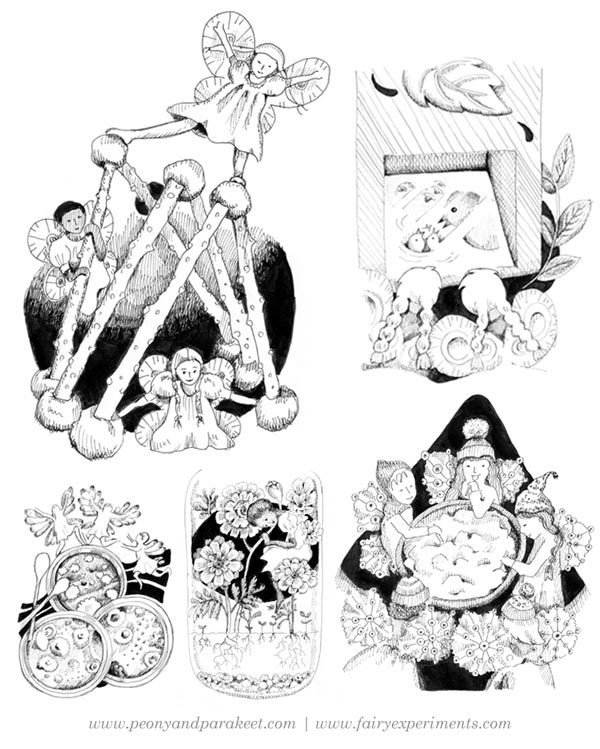
In these illustrations, fairies rule and take care of the world but also have fun. The book is all about exploring life’s miracles like the circle of life with step-by-step instructions.
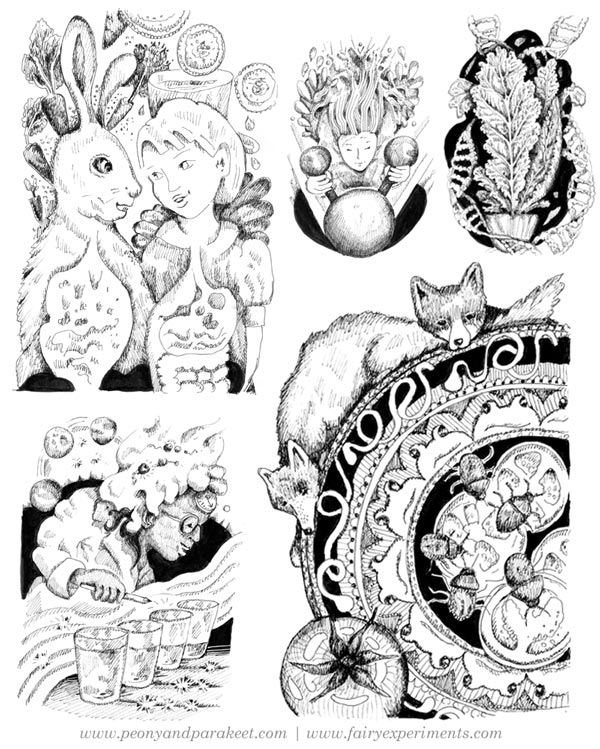
With the book, the child becomes part of the royal guard of fairies, so my job was also to design a badge that could be colored. Here’s the badge with the rest of the visual world.
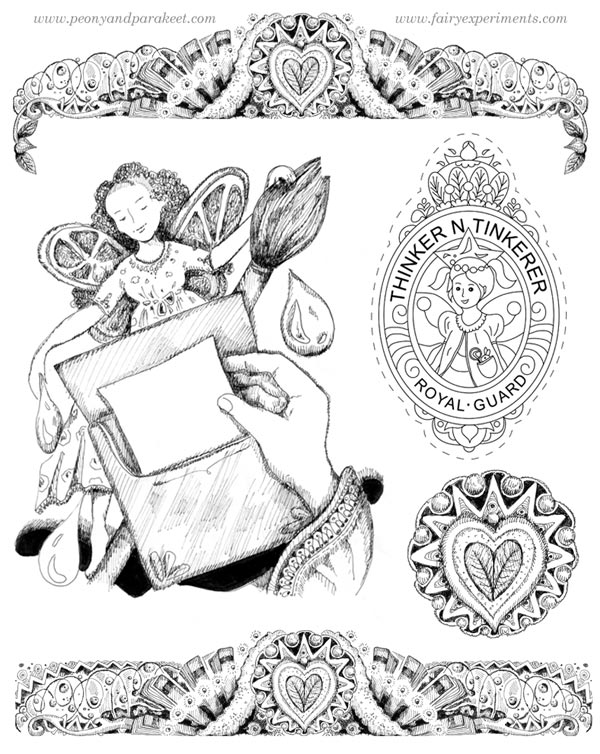
Expressing Natural Science as Ornaments
My favorite part of the projects was to design ornaments for fairy families. I hand-drew them all and used a computer only to make them symmetric.
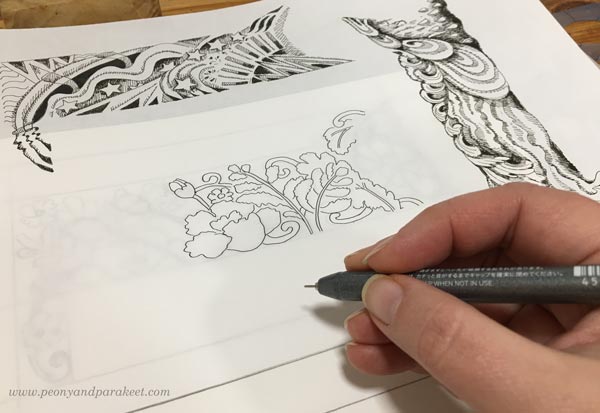
These ornaments take ideas from the illustrations and express the major chapters in a decorative way. They mark the chapters and make the book look more Victorian.
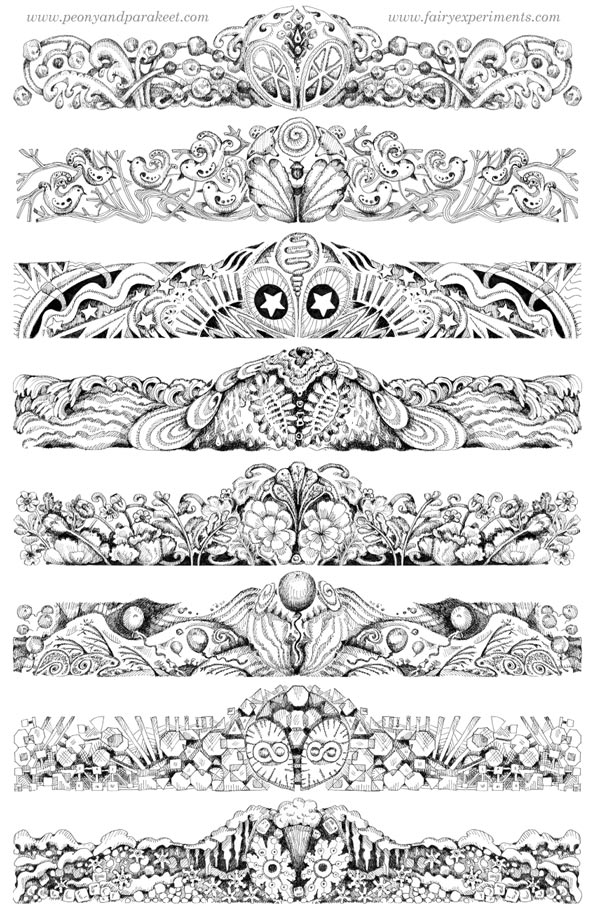
I hope you enjoyed this sneak peek to the upcoming book Fairy Experiments for Thinkers and Tinkerers by C.L. Hunt!
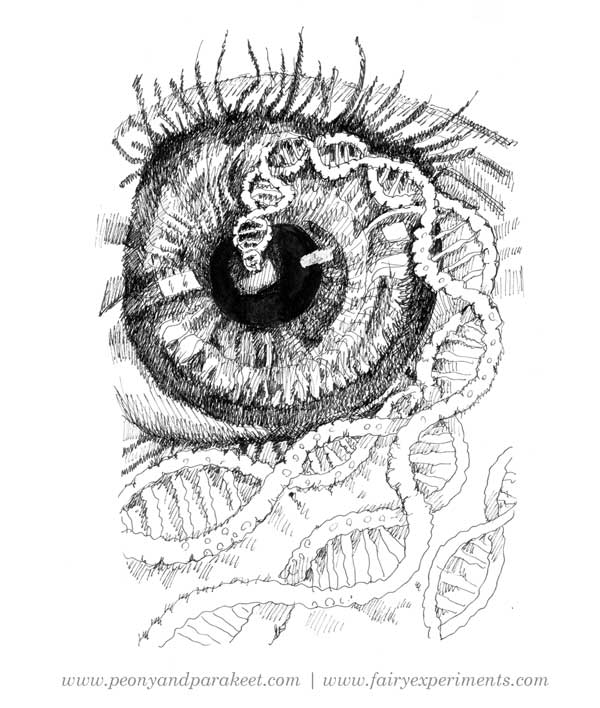
Learn to Draw with Me! I teach line-drawing techniques (+ using your imagination) in my classes Animal Inkdom and Magical Inkdom!
Hire Me as an Illustrator! See my portfolio in Hire an Illustrator!